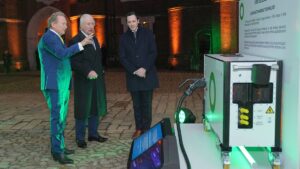Monsters of Rock: BHP iron ore boss waves off South Flank jitters as it rolls out homemade ore cars

Mark McGowan with BHP Asset President WA Iron Ore Brandon Craig. Pic: Colin Murty
- BHP iron ore boss Brandon Craig says South Flank grade variability won’t hit price realisation in the Pilbara
- The world’s biggest miner has started a trial to manufacture ore cars in WA
- Junior iron ore miner Fenix bucks the inflation trend to rein in costs
BHP (ASX:BHP) has staked much on the US$3.6 billion development of the South Flank mine, the largest iron ore development in WA for decades with an eventual steady state run rate of 80Mtpa.
It is also important because of its predominance of lump iron ore, a premium material over standard 62% Fe fines, which draws a higher price because of both its grade and because it can enter the blast furnace without being treated in the energy and carbon intensive sintering process.
South Flank, part of the Mining Area C zone near Newman, has made BHP the largest lump producer in the world, a brand that will comprise 33% of its product mix at its peak.
The mine is ahead of schedule, with its full capacity expected to be hit around 2024.
BHP’s results today were ho-hum outside of a weather hit (but probably still wildly profitable) coal division, a picture of dull and uncontroversial competence.
After a solid first quarter its plan to export 278-290Mt of iron ore from the Pilbara this financial year remains on track, but a small note on grade variability at South Flank did raise a couple eyebrows.
“Natural variability in the ore grade is expected as the mine progresses through the close to surface material, however this is expected to stabilise as we move deeper into the ore body and achieve full ramp up,” BHP said in its quarterly activities report.
Talking to media today, BHP’s WAIO asset president Brandon Craig said waved away any concerns it would impact price realisation — the percentage of the benchmark iron ore price BHP receives for its sales, which last year sat at 98.5%, the best out of the Pilbara majors.
“We don’t expect that to have any material impact on on price realisation. So it’s not surprising when you’re ramping up a mine like South Flank in its first two years, particularly when you’re running hard and you’re near surface, that you’re gonna get some level of grade variability,” Craig said.
“We’ve seen that at South Flank, we see it as a temporary phenomenon, it’s not going to last for a particularly long time and what we’re seeing in the market currently is that’s not having a material impact on our business in any way.
“So we’re pretty comfortable, we’re going to work through that, we understand it and South Flank as a project is still an outstanding success and continues to go from from strength to strength.”
Australia made ore cars
Craig was fronting the media in Bassendean today following BHP’s results and the start of a four-year trial to deliver 140 new ore cars made locally in Perth alongside WA Premier Mark McGowan.
The “flatpack” ore cars are being built by CIMIC-owned UGL at its workshop in the Bassendean industrial district with parts supplied by China’s QRRS.
It marks the first time the work has been done on WA shores in a decade.
BHP runs around 10,000 ore cars at its extensive Pilbara mining operations, replacing a few hundred each year.
“We have a fleet of over 10,000 ore cars inside the business and the routine replacement of them is pretty critical,” Craig said.
“As you know, social value is something that’s really important for us and we think there’s huge value in learning how to create a productive industry manufacturing ore cars here in WA.
“Ultimately, we would like to be able to get the manufactured potentially all the way up into Port Hedland, where we can actually manufacture them at the point of where we use them, so we can go straight from manufacture straight onto our lines and straight into production.”
Inflation is everywhere, but one miner is deflating
While costs are running rampant for Australian miners, junior iron ore producer Fenix Resources (ASX:FEX) says it has made headway in reducing its bill to run the 1.3Mtpa Iron Ridge mine in the Mid-West, with C1 costs falling from $91.53/wmt FOB Geraldton in the June quarter to $84.14/wmt in September.
It comes after the company bought out its haulage provider Newhaul, taking the service in house, while shipping costs also fell from US$32.2/dmt to US$26.6/dmt.
Before a $10 million hedging arrangement was included, Fenix sold its ore — largely consisting of high grade fines and lump — at an average of US$105/dmt, compared to US$142/t in the June quarter.
But it still generated a decent C1 margin for a junior iron ore miner of $26/dmt on 361,000t of iron ore shipments.
FEX finished the quarter with $94.5m in the bank, down from $101.9m on June 30, after paying a 5.25c per share dividend on the back of a $50.7m after tax FY22 profit.
Fenix ended the trading day up 2%, with lithium miners the strongest performers as the materials sector rose 0.81%.
Singapore iron ore futures fell 0.79% in the afternoon to US$91.90/t.
Fenix Resources (ASX:FEX) share price today:
UNLOCK INSIGHTS
Discover the untold stories of emerging ASX stocks.
Daily news and expert analysis, it's free to subscribe.
By proceeding, you confirm you understand that we handle personal information in accordance with our Privacy Policy.








